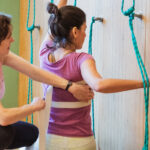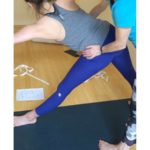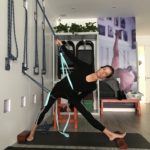
Workshop Yoga und Skoliose für Erwachsene
Ort: Iyengar Yoga Zentrum Berlin, Hochkirchstrasse 9/2, 10829 Berlin
Zeiten: Sonntag, den 21.04.2024, 12:00 – 15:00 Uhr
Kosten: 43,00 €
„sagenhaft, wirklich großartig!!!
Herzlichen Dank für die viele Mühe und den Aufwand, den du in Vorbereitung, Durchführung und Nachbereitung gesteckt hast!
Ich konnte total viel für mich mitnehmen.“ Beate R. (12.03.2024)
„Dein Workshop hat sehr grosse Spuren in mir hinterlassen. Anfangen von dem genauen inneren nachspüren der Skoliose-Spirale (Berg-Tal-..) Ich habe ältere Röntgenbilder nochmal studiert, um von „aussen“ drauf zu schauen. Die Übungen waren fantastisch gut. Ich habe die mir vertrauten Yogaübungen ab sofort ganz anders fühlen und durchführen können, eben von innen nach aussen, und nicht von aussen nach innen….“ Evelin G. (12.10.2023)
„Ich freue mich auf Deinen Workshop. Deine Workshops tun meinem Rücken immer gut und ich habe danach immer eine bessere Wahrnehmung für meine Haltung und meine Skoliose. Außerdem fühle ich danach mehr Freiraum in meinem Rücken.“ Charlotte H. (27.08.2023)
„ganz herzlichen Dank für die wertvollen drei Stunden am Sonntag! Ich habe enorm von den Übungen und einem veränderten Körperbewusstsein profitiert und erkannt, dass ich dringend eine regelmäßige, betreute Anbindung benötige.“ Anja S. (04.07.2023)
„ich mache den Workshop zum 2 ten Mal weil ich so begeistert war und zur Vertiefung wiederhole ich. Eine Patientin von mir ist auch angemeldet. Ich freue ich schon sehr und lasse mich überraschen. In der täglichen Arbeit mit den Patienten wende ich meine Erfahrungen mit Dir an und habe große Erfolge.“ Elke S. (15.02.2023)
„Du hast so einen wertvollen Workshop gemacht. Ich kann damit ganz viel anfangen, sehr inspirierend. Du hast dir unheimlich viel Mühe gegeben und man spürt es dass du es lebst. Dankeschön.“ Smaragda P. (31.07.2022)
„vielen vielen Dank für diesen tollen workshop heute!! Es hat mir soo gut gefallen und meinem Rücken sehr gut getan. Ich fühle mich viel aufrechter, ein bisschen bewusster für meine Asymmetrien und fühle mich mental und physisch gestärkt.“ Anja N. (24.04.2022)
„Thank you so much for the workshop notes. It is so helpful for me to focus on practice during the workshop and review the sequences I learned later. I admired your passion and motivation in learning and teaching. I enjoyed experimenting and experiencing with you in an empathetic environment for learning. I certainly felt more elongation and more space in my body under your guidance. I feel so happy to have found you and I really hope that more Iyengar Yoga teachers learn/understand/accept yoga for scoliosis work.“ Junko S. (20.03.2022)

This workshop will be taught in english.
This workshop aims to help students of Yoga address the specific challenge of practising yoga with an assymetrical body, as well as using the principle of alignment (so central to Iyengar Yoga) to counter asymmetric tendencies within.
The workshop is open to all, beginners looking for new ways to address scoliosis, practitioners looking for help in their yoga practice, as well as teachers wanting to help students.
Where: Iyengar Yoga Zentrum Berlin, Hochkirchstr. 9/2, 10829 Berlin and parallel ONLINE (Zoom)
When: Sunday 7th July 2024, 12:00-3:00 pm
Workshop Yoga und Skoliose für Erwachsene
Ort: Iyengar Yoga Zentrum Berlin, Hochkirchstrasse 9/2, 10829 Berlin
Zeiten: Sonntag, den 26.05.2024, 12:00 – 15:00 Uhr
Kosten: 43,00 €
Yoga and Scoliosis – My journey
by Helen Barsby
Why yoga? In yoga we train the body, the breath and the mind to become free from fluctuation, misalignment, misconception, to come into freedom, stability, and a contented balanced state with oneself. This is the perfect tool for someone with a non-aligned body. The essence of yoga is non dualism. This is the balance of individual and cosmic consciousness, of ego, mind and Self, of body and mind, and on a basic level the balance between the left and right sides of the body.
Scoliosis (Ancient Greek- a bend)
Scoliosis means a bent spine. The term was introduced by Hippocrates the Greek physician (often called the father of modern medicine) in the 5th Century BC to describe the lateral deviation of the spine. Around 3% of the world’s population has scoliosis.
One common deviation from the centre line, is the appearance of a sideshift of the thoracic spine to the right. The body, in order to maintain a balance reacts producing other curves to the left above and below this main curve. Why does this occur? Why most commonly in adolescent females? In addition to the sideshift off centre there is a rotational action pushing the scoliosis. The ribs in the right chest are then pushed not only outwards but also backwards. This is the easily visible hump which can be seen when bending forwards, as in the Adams test used by pediatricians. The other deviation, often seen in elderly persons, is the sideshift of the pelvis, where the major curve of the spine occurs in the lumbar spine.
Scoliosis can be passed on genetically, or is perhaps caused by the blockage of cerebrospinal fluid flow during foetal growth. It can occur in adolescence where the rapidly growing body grows out of kilt, and it can also arise as the result of incorrect posture, or of deviations in leg length, and from extreme onesidedness.
When scoliosis becomes evident it is always better to intervene immediately. Especially in adolescents who still have soft and growing skeletons, there is the chance to reduce the curves of the scoliosis. With adults, the approach is more conservative, we work to counter any further scoliotic progression. Yoga for scoliosis is not about healing a scoliosis, it is about creating and maintaining the highest possible quality of life. This means freedom in movement, freedom from pain, freedom to breathe, and freedom from the discomforts of misalignment. With hard work improved posture can be achieved and this can only be maintained through regular practice. Yoga is a practical discipline, a never-ending study of the self.
Living with scoliosis – my story
I am one of these typical idiopathic cases. First noticed by my mother at the beach as a thirteen year old, my scoliosis was then measured and monitored in my native New Zealand, and at aged seventeen was deemed, with its 45º major curve, borderline. Operate, and straighten the spine permanently, or wear a brace? Both options I rejected- thinking purely of my own lifestyle at the time, with lots of sport commitments, and my hobby of playing the trumpet.
By the time I was nineteen problems began to occur. I was studying to become a professional trumpet player at Music College, practising, and investing more than ever before. Tension in the right upper back, shoulder, upper arm increased, and sitting still in chairs was becoming more and more uncomfortable (the pain radiated from the apex of the outer curve of the spine). I realised that I had to do something about it. I needed to add body work to my practise routine, I needed to replace sport for fun (especially things like squash games after the saturday orcherstra rehearsals) with a specific routine, which would counter the problems I was having. As a music student in Detmold, Germany I discovered yoga, at the age of twenty three. Immediately I knew that this was something for me. Luckily it was Iyengar yoga, which is so precise, so effective, and so penetrating. I knew here that I could help myself, and had a method with which I can keep the pull of the scoliosis in check, if not, as I later discovered, actually improve my scoliosis.
I was fortunate to be exposed from the beginning to the Iyengar school of yoga teaching. Iyengar yoga is renowned for its precision. B.K.S. Iyengar (after whom the school is named) himself never ceased from delving deeper within himself to perfect yoga asanas. Up until his ninety sixth year in 2014 he practised yoga several hours a day, surrounded in his institute by his students and followers. He was often known to take over a class in order to make a point more clear. He oversaw the daily medical class, where therapeutic benefits of asana work was put into practise. It was in this class in Pune in 2006 that I had my first intense experience of the effect that Iyengar yoga can have on my body. Four hours per day of a special programme, tied up in a corset of belts to guide me to straightness, gave me the taste of the freedom to be gained when contracted parts of the body begin to open up, when overstretched parts are restricted, and when alignment starts to come.
The wonderful thing about yoga is that anyone can start at any age. All the asanas can be modified, simplified or supported by using props such as chairs, belts, ropes, blankets, bolsters and blocks. The Iyengar teachers never stop to learn how to modify the classical poses to suit the individual students.
The different geometric forms we practise in the asanas present us with case-studies: How does my own body react to this form? How can I bring my body into alignment? Especially the poses where a left and a right side are practised, the differences show themselves immediately. What has been learnt in one pose (asana) can be applied to the next one, which may be a more complex one, we are always searching for the connections, the communication between the body parts, and between the intuitve mind and the analytical mind, between the breath and the body. We are trying to penetrate the dull areas, which don’t respond easily, coming into a sense of balance and fullness, literally living life fully. Iyengar has said that where there is contraction there is no life. In these dark contracted areas we need to create space, and to fill that void with new life and energy (prana). The breathing exercises from yoga (pranayama) are of immense effect in achieving an inner balance.
One major step which yoga has helped me to take is the practise of self study. I knew early on that I wanted to remain independent of doctors and of outside help. Through knowing which part of the body is overdoing or underdoing in a pose on its right side and again on its left side, comes the beginnings of correcting the pose, and ultimately the spine.
People with scoliosis often have no concrete idea of exactly what is out of alignment. Using yoga poses such as lateral standing poses, or the supine postures gives us this insight. In yoga we practise to stay in the postures, in order to ideally find poise in the pose, to find, through effort, effortlessness. B.K.S. Iyengar has helped even further in this by experiencing the postures deeper through the help of props and supports. Examples of the props introduced by Iyengar are blocks, belts and ropes. A block placed under the foot of the out-turned leg in the standing poses gives immediately more feedback about the connection between that leg and its hip socket, this connection is the key towards working with the spine. Standing poses against a wall, or indeed lying supine on the floor help our awareness of better alignment. Iyengar then penetrated further, using his body as his own prop: one part supporting the next to obtain mastery of the pose, penetration within, quietness in the mind and contentment.
Through holding the poses (as opposed to always staying in a flow of movement), the muscles are called upon to work, some needing more contraction (on the outer side of the curves), and some needing more lengthening (the contracted inner sides of the curves). We gain more strength in the body, strength with which we can maintain a right posture, strong enough to counter the scoliotic forces permanently at work in the body.
My three hour long workshops, which have a bimonthly rhythm, are open to anyone interested in working on scoliosis through yoga. Many participants are unsure which yoga poses are good for their scoliosis, some have specific issues with a particular pose. The workshops are about learning individualised adjustment, that we each learn the difference between a right and a wrong pose. Right being an improvement of the scoliois in any one yoga position, wrong being a position which allows the scoliotic tendencies to flourish. The workshops have a different focus each time, and we spend most of the time using the basic forms of the yoga asanas, to help the body towards alignment. Awareness is schooled as is contact with one’s own body. We become conscious of breathing habits and postural habits, both of which need breaking in order to reprogramme one’s posture. We work on strengthening the back, the flanks, the legs and the arms.
Poses important for those with scoliosis:
All supine poses, whereby the floor gives feedback about the alignment of back of the body: the contact of the ribs, shoulders, sides of the waist and the pelvis tell us what needs to be brought into balance. Leg and Arm stretches in the supine position train the freedom of the limbs, so crucial to Iyengar yoga (Supta Padangusthasana).
Supported forward bends, for example lying forwards supported by a chair. Here an awareness of the frontal deviations, and weaknesses in the back muscles become apparent. Also we do leg and arm stretches- moving towards Dog pose (Adhomuhka Svanasana).
Twisting action to derotate the spine, the ribs and the pelvis (Parsva Adhomuhka Virasana, or Parsva Adhomuhka Svanasana).
Side plank, either raised on the elbow, or lying, which trains the left and right sides of the body (Vasisthasana).
Link zu der veröffentlichten Artikel auf deutsch in Yogaeasy:
https://www.yogaeasy.de/artikel/yoga-und-skoliose-erfahrungsbericht

Wieder in diesem Jahr wird Marcia ihren in Berlin geplanten Workshop für Yoga mit Skoliose via Zoom unterrichten.
Dieser Workshop ist gerichtet an alle die trotz Asymmetrien auf der Suche nach neue Möglichkeiten im Yoga für eine Öffnung des Körpers sind. Der Workshop ist weder um Skoliose zu heilen, noch für persönlichen medizinischen Gegebenheiten gedacht. Der Workshop ist praktisch und braucht guten physischen Kondition.
Marcia schreibt: „Das spüren von Disbalance kann uns beunruhigen. Wir üben um bessere eigene Wahrnehung zu bekommen, und wie wir davon profitieren können in unsere Yoga Praxis und allgemein. Wir wollen eine verbesserte Haltung, Raum, Kraft, Stabilität, Balance, Fokus and Atembewusstsein schulen.“
Voraussetzung: mindestens 6 Monate regelmässige Iyengar Yoga Praxis
Geeignet für Schüler*innen und Lehrer*innen mit geringen Rückenproblemen, Asymmetrien und Skoliose.
Zeiten: Freitag den 08.07. von 19:00 – 21:00 Uhr, Samstag den 03.07. von 14:00 – 17:00 Uhr, Sonntag den 04.07. von 14:00 – 17:00 Uhr
Kosten: 120 €
Unterrichtssprache: Englisch (mit deutscher Übersetzung). Wir werden allen Teilnehmern Anleitungen zum Setup der Übungssituation zu Hause zusenden, sowie eine Liste von Hilfsmitteln zusenden.
Bei Fragen: helen@yoga-skoliose.de, Telefon: 0172 / 9417236
In unserer Bildergalerie erhaltet Ihr einen Eindruck vom Workshop aus 2017:
‚Yoga as a life process‘, Marcia Monroe talks to Claudia Lamas about her own story coming to yoga with scoliosis, about her upcoming Workshops in this summer in Europe (Berlin, Zug-Switzerland, and Lisbon-Portugal). You can read the interview here.
Neueste Kommentare